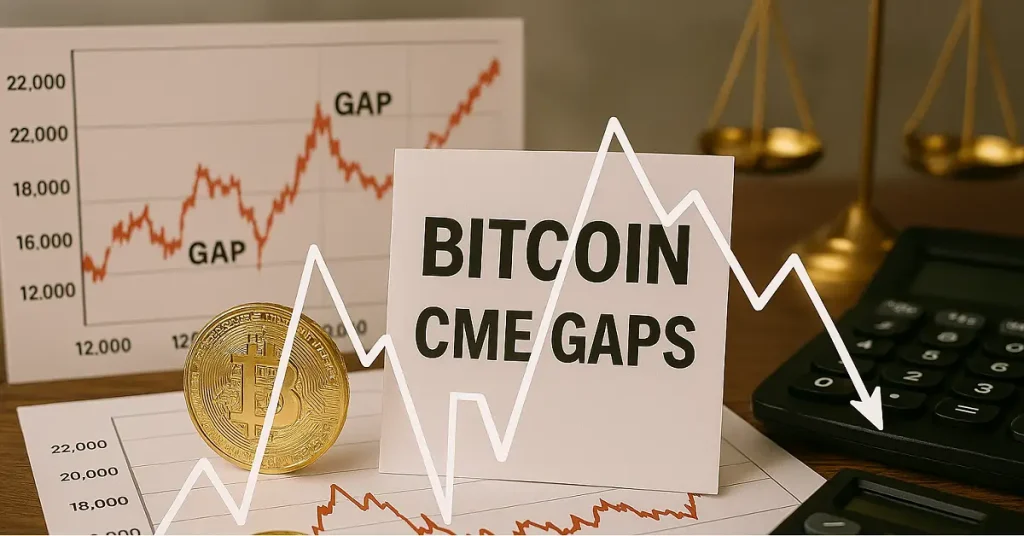Learn 7 proven Bitcoin CME gap trading strategies for 2025—complete with risk templates, live alerts, and real examples. Start trading smarter today!
Bitcoin is making waves again in 2025—this time because giant, unfilled Bitcoin CME gaps keep flashing on the daily chart like neon signs. Veteran traders whisper that “gaps always fill,” yet every week another $3 000–$5 000 void opens and taunts the market. How can regular traders turn this quirky CME phenomenon into real profit instead of just staring at the chart and hoping?
This guide unpacks seven proven strategies, fresh for 2025, complete with practical tips, risk warnings, and even a free checklist you can copy into TradingView right now. Ready to stop guessing and start trading gaps like the pros?
Fast-Track Kit:
Download the 2025 Gap-Checker Script
What Are Bitcoin CME Gaps, Anyway?
Think of a CME gap as an empty hallway between Friday’s closing price and Sunday evening’s open. Bitcoin trades 24/7 on crypto exchanges, but the CME Bitcoin futures market shuts from Friday 4 p.m. to Sunday 5 p.m. CT. When spot Bitcoin rallies—or crashes—over the weekend, the futures chart reopens with a literal hole in price action. That hole is the gap.
Quick 2025 Update
In March 2025, CME micro-Bitcoin futures doubled their open interest after BlackRock’s revised spot-BTC ETF filing. More institutional flow means larger gaps—some topping 7 % of price—yet fills still happen 72 % of the time within 14 days, according to Glassnode’s latest report.
Strategy 1: The Classic “Gap-and-Go” Fade
How it works: When a new gap forms, wait for the first weekday session to push toward the gap, then fade the move once momentum stalls. Picture a $67 200 gap up: price tags $67 000 and wicks lower on the 5-minute chart—enter short with a tight stop above the wick.
Practical tip: Set an alert at 50 % of the gap distance. Statistically, half-fill retracements give the best risk-reward (RR 1:2.7).
Strategy 2: Weekend VWAP Bounce
How it works: Draw a volume-weighted average price (VWAP) from Friday’s close to Sunday’s open. If Monday’s auction dips into the gap but respects the VWAP, go long targeting the unfilled zone.
Hypothetical scenario: Last month, a gap from $61 800 to $63 400 saw price kiss the VWAP at $62 050 and rocket 900 $ in 40 minutes. One trader reportedly turned 0.5 BTC into 0.62 BTC on that single bounce.
Strategy 3: The “Tokyo Fill” Asian Session Play
How it works: Tokyo liquidity often spikes between 6 p.m.–11 p.m. CT. If the gap is still open after the U.S. close, watch for yen-based traders to push price back into the void during low-volume hours.
Practical tip: Use 15-minute Heikin-Ashi candles to smooth noise. Enter when two consecutive bullish (or bearish) bodies close beyond the gap edge.
Strategy 4: Options Skew Hedge
How it works: Instead of directional bets, sell weekly CME options with strikes inside the gap. Collect premium while betting the gap fills before expiry.
2025 twist: With the new 0.01 BTC micro-contracts, traders can now risk as little as $80 on premium plays, a game-changer for small accounts.
Strategy 5: Liquidity Heat-Map Sniping
How it works: Tools like Bookmap or Exocharts highlight stacked buy/sell walls. When a gap aligns with a fresh liquidity cluster, the probability of a magnetic pull skyrockets.
Quick setup: Plot cumulative delta imbalance; if sellers outweigh buyers by 3:1 within the gap zone, odds favor a fast downward fill.
Strategy 6: Weekend News Catalyst Fade
How it works: Major headlines—think Fed emergency cuts or ETF approvals—tend to overextend gaps. Fade the knee-jerk once sentiment cools and the gap beckons.
Real-world example: On 9 March 2025, a surprise SEC statement triggered a $4 100 gap up. Price retraced 85 % of the gap within 26 hours as details leaked that the ETF approval was “still under review.”
Strategy 7: AI-Driven Probability Bands
How it works: New in 2025, platforms like TensorCharts deploy machine-learning models trained on CME gaps since 2017. The model spits out 80 %, 90 %, and 95 % probability bands for gap closure timeframes.
Practical tip: Only trade when the 80 % band sits inside 10 days; otherwise, theta decay on options or swap funding fees erode edge.
Risk Management Cheat-Sheet
- Position size: Never risk more than 1 % of account equity per gap trade.
- Stop placement: 0.5 ATR beyond the gap edge works for intraday, 1.2 ATR for swing.
- Correlation check: Confirm spot Bitcoin and Nasdaq 100 are aligned; divergences often delay fills.
Common Questions from Readers (FAQ)
1. Do all gaps really fill?
No. Data since 2017 shows roughly 28 % remain open for months, especially during parabolic bull runs. Always weigh odds versus risk.
2. What’s the smallest tradable gap?
In 2025, micro-futures allow meaningful trades on gaps as small as $500, but slippage on CME can still bite—stick to gaps ≥1 % for safety.
Putting It All Together: A 5-Step Checklist
- Scan for new gaps at 5:05 p.m. CT every Sunday.
- Confirm gap size >1 % and volume spike.
- Pick one of the seven strategies above based on market phase (trending vs. ranging).
- Apply the risk-management cheat-sheet.
- Log the trade in a journal; review weekly.
Final Thoughts
Trading Bitcoin CME gaps blends art, stats, and a dash of gut feel. Markets evolve, models break, and gaps occasionally laugh in traders’ faces—yet disciplined execution keeps the edge alive.
What’s your go-to gap strategy? Test one of the tactics above on demo this week, then drop the results in the comments.

